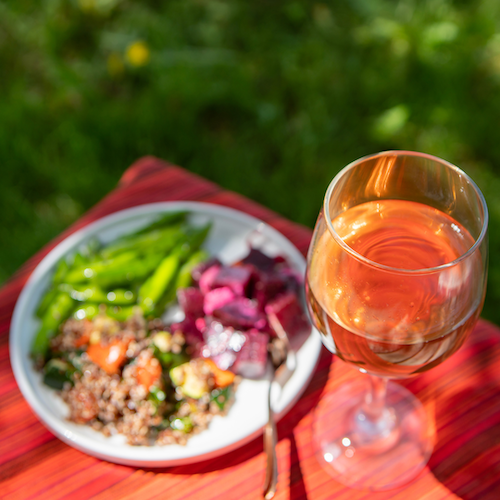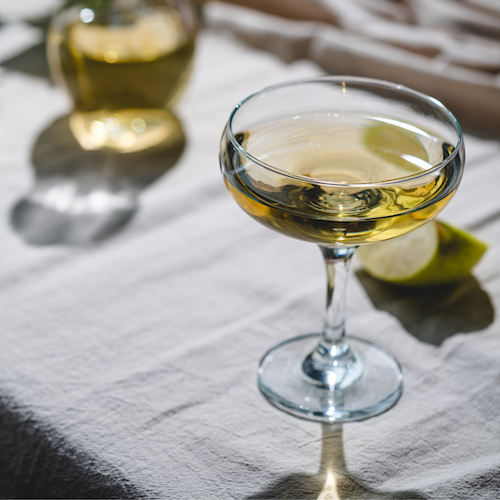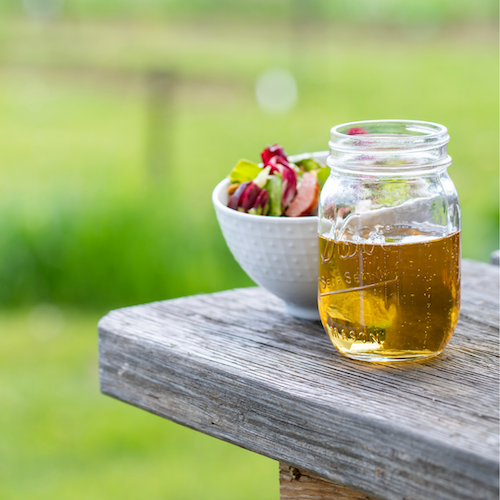Dry Cider July
Dry Cider July Looks to Celebrate 0g Residual Sugar Ciders

The ACA’s Dry Cider July campaign is set to launch on July 1, 2024 as a way of highlighting ciders containing zero grams of residual sugar. We encourage everyone to join the campaign through social media with the hashtags #dryciderjuly and #pickdrycider!
There is a common misconception that all ciders are sweet. The ACA is out to bust this cider myth–it’s actually easy for a cidermaker to ferment their cider to 100% dry leaving no sugar in the final product. For those looking to limit their sugar intake or who prefer the flavor of dry ciders, we have put together a database of producers and offerings that make finding these ciders easier for consumers.
The range of ciders in the Dry Cider Finder reflects the vast possibilities of flavor and styles possible in cider, even without sugar. From single varietal ciders, showcasing specific apple varieties and served in a 750 ml bottle, to ciders aged on rose petals and sage and served in a 12 oz can, and everything in between.
The Dry Cider Finder can be found on our website.
If you are a cidery and have 0g residual sugar ciders that you would like to have showcased in the directory, please fill out our form here by June 18th, 2024 to be included on this year’s list. You must be an active ACA member to be included in the Dry Cider Finder.
For any questions regarding the Dry Cider July campaign, please don’t hesitate to reach out to our Membership and Engagement Coordinator Miranda Bradeen.
Crack the Code: Your Guide to Finding Dry Cider in the Supermarket
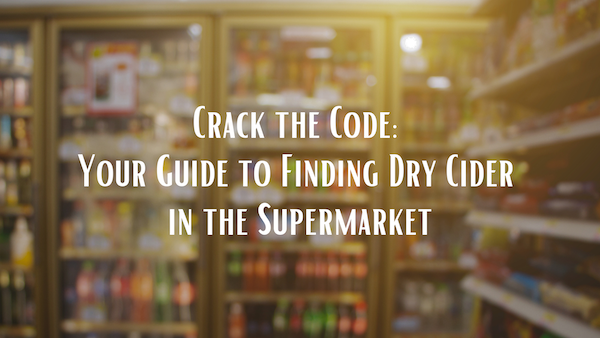
Ready to get in on the fun this Dry Cider July? Let’s talk about the best ways to find dry cider at the supermarket. With a plethora of options from fruity summer flavors, botanical ciders, and distractingly beautiful labels, it can be hard to determine which ones are dry. Thankfully, there are some telltale signs whether the cider that’s caught your eye is dry or not.
First, let’s talk about the difference between dry vs. sweet cider labels. Ciders in the U.S. are labelled based on their residual sugar, and fit into one of four categories: Sweet, Semi-Sweet, Semi-Dry, or Dry. This month celebrates the driest of the dry. Dry ciders have 0 grams of sugar and what we’ll be focusing on. We’ll also touch on semi-dry ciders if that’s more your speed. It still counts on the ‘gram. So, how to choose? Here are four strategies to determine whether or not a cider is dry.
Cider Name or Subtext
On the face of the cider, the can or bottle should have a name. If the name or subtext includes dry, semi-dry, off-dry or brut, we’re on the dry end of the spectrum. Conversely, if we find sweet or semi-sweet listed, we can eliminate those options.
Brut aside: Brut is a style of cider modeled after the French Brut Champagne. Cideries take different approaches to honor this beverage’s French origin by means of aging the cider on French wine barrels or using champagne yeast. What all Brut ciders have in common is their sparkling nature and zero grams of residual cider.
Cider Descriptors
Another way to tell if the cider in your hand is dry is to spin the can around and look for descriptors provided by the cidery. Many cideries provide a brief description of the cider, highlighting tasting notes and how to best experience it either temperature-wise or with food pairings. Some cideries go above and beyond by providing a sweet-to-dry sliding scale, denoting where this particular cider falls.
Sugar Content
If the other two methods haven’t brought you an answer yet, another option is to check the nutritional facts. This method can be unreliable as nutritional facts are not universally required for cider. However, if the nutrition facts are available, check how many grams of sugar are in the can. Generally, if there are 0-3 grams of sugar in a 16 oz can, you are squarely in dry country. If you’re more in a semi-dry mood, look for 4-10 grams of sugar.
Earlier this month in the ACA blog, Tim Godfrey highlighted that a dry cider might not taste dry after all. My favorite examples of this phenomenon are fruit ciders and ciders featuring the McIntosh apple. Fruit ciders bring their own character to the table and the fruitiness can trick our brain into thinking a cider with 0 grams of sugar is a sweet cider. Similarly, McIntosh apples are flamboyant, botanical apples that bring what our brains interpret as sweetness to the drink. These ciders can provide a different kind of dry cider experience.
Zero (or no) Sulfites
This final strategy to determine if you have a dry cider is a tried but not always true method. Look to see if the can lists zero (or no) sulfites. The addition of sulfites is a common method to stop the cider’s fermentation process before the cider is fully dry. If the cider lists that it is sulfite-free, you most likely have yourself a dry cider. Many cideries let their cider go completely dry to negate the need for sulfites. Because sulfites are a method of halting fermentation before a cider is fully dry, their presence likely indicates a sweeter cider. Note that some cideries may choose to add sulfites to their dry cider as a precautionary measure.
Whichever method you choose to follow here, listen to your gut. What sounds good to you? What flavor profile will appeal to your friends at the bottle share? And, if you follow these tips to your next favorite dry cider, let us know on Instagram using #dryciderjuly and #pickdrycider. Cheers!
Want a cheat sheet for dry cider near you? Check out our Dry Cider Finder!

Alexsis Cassady is a cider influencer and Certified Pommelier™ who can be found on Instagram @ciderminded.
Delicious Cocktail Concoctions for Dry Cider July
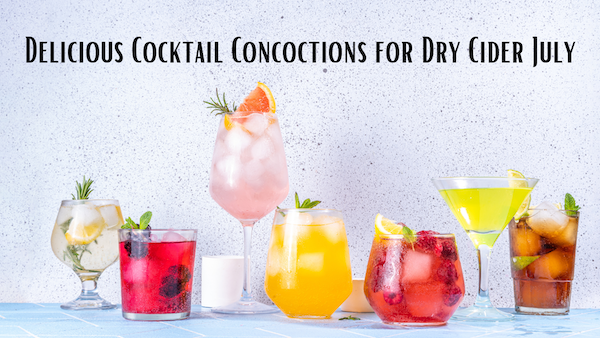
Summer is my favorite time of year for cocktails, from lazy beach days to backyard barbecues, or just relaxing under the warm sun, every activity is ripe with cocktail possibilities. It doesn’t hurt that we are surrounded by fresh juicy berries, crisp veggies, and citrus galore. I can think of no better way to enjoy the bounty of the season than to create dry cider cocktails for any palate.
Basic Rules for Cocktails
When it comes to creating your own cocktail recipes, there are a few basic rules that can really up your game.
- The 3 Ingredient Formula: Classic cocktails tend to follow a similar and reproducible 3 “ingredient” formula. Base liquor, ingredients to add sweetness, acidity, or both, and then your extras. The goal of the 3 ingredient formula is to create the perfect trifecta of balance and to be a building block for endless cocktail variations.
- Ice: Should your drink be shaken, stirred, or built? Should your drink be served up or on the rocks? The accepted “rule” is to shake if there is citrus in the cocktail, and to stir if the cocktail is spirit heavy. Built cocktails, also known as mixed drinks tend to be one liquor and one mixer with no added acid or sweet ingredients.
- Ratios: As for ratios, I like to start by considering the “golden rule” or 2:1:1. That is 2 parts spirit to 1 part sweet and 1 part sour. While I do use the word “rule”, I do say that with a grain of salt. These are more guidelines than hard and fast rules and are meant simply as a starting point for your cocktail constructions.
How Dry Cider Fits In
Now that we have our basic cocktail formula down, we can start to piece in cider to our formula. There are a few basic parameters to help in choosing just the right cider.
First, we can break any cider down into its base components: Sweetness/ Acidity/ Tannin
Because we are looking for cocktails using only dry cider, that leaves us with the following 4 categories.
- Dry high acid, high tannin
- Dry low acid, low tannin
- Dry low acid, high tannin
- Dry high acid, low tannin
Along with these categories, be sure to also consider fruitiness or perceived sweetness in the cider.
Next, we can break a cider down even further into basic mouthfeel and flavor categories. This would include whether it is still or sparkling, barrel aged or not. We could even dive as deep as pinpointing its most expressive flavor elements, but to be honest, we don’t even need to go that far to make delicious cider cocktails.
Now we have our basic cocktail rules and we have our basic cider components we can start to construct some delicious cocktails. I started my list by venturing out to the local farmers market. I was struck by the number of delicious fruits, berries and cucumbers and even fresh eggs that caught my eye. This was the inspiration for these true summer cocktails.
White Linen a.k.a Cucumber Gin Fizz
This cocktail is a refreshing crowd pleaser.

- 1.5 oz. gin
- .5 oz. St. Germain
- Cucumber
- Fresh lemon juice
- .5 oz. simple syrup
- Saline spray (optional)
- Top with a dry floral cider
- Cucumber ribbons for garnish
Muddle cucumber in a shaker, add gin ( I like Hendricks in this application), St. Germain, simple syrup, and fresh lemon juice. Add ice, shake well and double strain
Upstate New York Sour
Elegant and beautiful, this twist on a classic cocktail is sure to please.
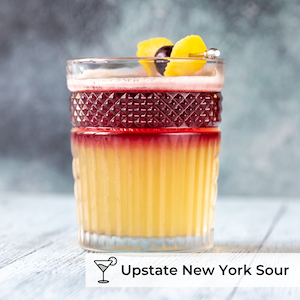
- 2 oz. bourbon
- .75 oz. simple syrup
- 1 oz. fresh lemon juice
- 1 egg white
- 1.5 oz. dry tannin forward cider
- Bourbon-soaked cherries for garnish
Add bourbon, simple syrup, lemon juice and egg white (or vegan foamer) to a shaker and dry shake to incorporate all the ingredients and achieve a nice foamy texture. Add ice and wet shake. Strain into a rocks glass and add a large ice cube. Using the backside of a bar spoon, float 1.5 oz of your favorite dry tannin forward cider.
Summer Cider Sangria
Looking to make a large batch cocktail that you can adjust ingredients based on what you have on hand? This is the perfect cocktail for any summer plans.
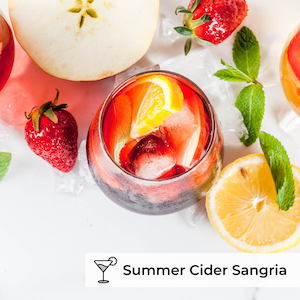
- 750ml dry cider
- ½ cup apple or pear brandy
- Apple or pear slices
- Fresh berries
- Fresh citrus
- Citrus round and mint or other fresh savory herbs for garnish
Combine your fresh fruit and cider of choice into a large pitcher and stir to combine. Once satisfied with the fruit infusion, add the brandy and lots of ice. If you prefer your sangria to be a little sweeter, add fresh juice or lemonade.
*Note: you can change up the fruits used to better suit your cider choice. If your cider is low in acid, you could use more citrus. If your cider is higher in tannin, you could use more juicy red fruits to balance.
Not sure which cider to use, check out the American Cider Association’s Dry Cider Finder for a fantastic list of dry ciders throughout the US.
Why Does My Dry Cider Taste Sweet?
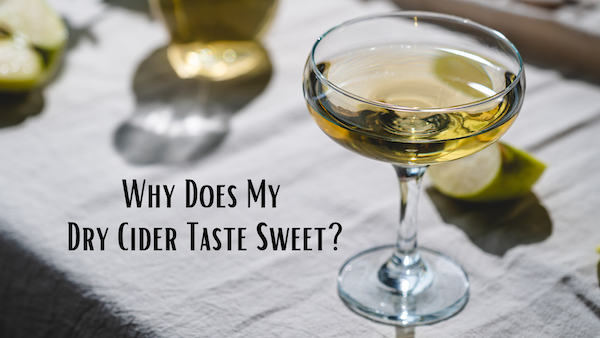
Written by Tim Godfrey
Cider has long dealt with assumptions and misrepresentations of sweetness. In fact, the first reaction when folks are asked about cider often relates to the question of how sweet it is. Curiously, this happens in cases where the cider is actually quite dry, but is adamantly proclaimed as sweet. Why is this?
In the realm of tasting and sensory evaluation, the distinction between perceptive sweetness and residual sugar presents a captivating conundrum for Pommeliers, industry professionals, and even the average drinker. These terms, though seemingly interchangeable, unveil distinct concepts that significantly influence our sensory experience. Perceptive sweetness encompasses the remarkable interplay of our taste buds and olfactory receptors, enabling us to perceive sweetness in a cider despite the absence or minimal presence of residual sugar. It is an intriguing phenomenon that relies on the intricate complexities of sensory perception. Our brain’s ability to deceive us becomes apparent as taste and aroma interact, conjuring a perceptual illusion of sweetness, even in ciders with restrained residual sugar content. This phenomenon is typically attributed to three other sensory characteristics of cider: Aromatics, Acidity, and Alcohol.
Aromatics
Ciders contain a vast array of aromatic compounds derived from various sources, including the apples themselves, fermentation, and aging processes. Fruity aromas, such as those reminiscent of ripe apples, citrus or tropical fruits, or any added fruit to the cider can evoke associations with sweetness, that we generally term “fruitiness”. Even in the absence of substantial (or any) residual sugar, the presence of fruity aromas can trick our senses into perceiving a cider as sweeter than it actually is. The same is true of ciders aged in oak barrels, which can contribute flavors such as vanilla, caramel, or spices. These additional aromas interact with the fruit character and create a sense of sweetness on the palate even when no sugar is present. This is likely due to the close link between the olfactory receptors in our noses that perceive these fruity aromas, and the taste buds on our tongues that perceive sweetness. Knowing how something will taste based on how it smells is anatomically connected as well. The olfactory receptors perceive aromas through two pathways: directly through the nose – “orthonasal”, and through the back of our throat – “retronasal”. This is all to say that our sense memories of fruit as “sweet” is complicated by the anatomy of aroma perception, creating perceptive sweetness when sugar might not actually be present.
Acidity
Our taste buds perceive five basic tastes, all of which interact and counteract each other in differing, complex ways. Acidity and Sweetness are two of these that tend to have a counteracting relationship and are foundational in our perception of cider. Acid tends to provide a light, refreshing quality to cider, whereas sweetness contributes viscosity and body. Balance is achieved when these two sensations are in harmony, but given their counteractive nature, the interaction between sweetness and acidity can influence our perception of residual sweetness. For example, high acidity tends to mask or diminish the perception of sweetness, resulting in a lighter, crisp body, whereas ciders with low acidity and high residual sugar can result in a cloying, syrupy sweetness, and “flabby” body. An overly sweet cider can be “fixed” with the addition of acid and vice versa, but this can be hard to discriminate as a taster. In cases where it is unclear whether or not real sugar is present, rely on your tongue to feel the texture of the cider rather than the taste.
Alcohol
Frankly, at the regular ABV of most ciders (5-8%) alcohol does not seem to bring the same perceptive sweetness impact as it does in wine. However, it is well known that the presence of alcohol in wine can amplify the perception of sweetness, and that premise could still apply to cider to a degree. Alcohol stimulates our sweet taste receptors, intensifying our perception of sweetness even in the absence of substantial residual sugar. This interaction between alcohol and our taste buds creates an intriguing sensory experience that can deceive our palate. Alcohol also contributes to the overall balance and integration of flavors in cider. It adds body, texture, and warmth to the cider, complementing other sensory elements. When combined with residual sugar, alcohol can create a perception of sweetness that is greater than the actual sugar content would suggest. Alcohol’s impact on body and texture also influences the mouthfeel and viscosity of cider. Higher alcohol levels impart a fuller, more viscous texture, which is similarly experienced in sweet ciders. So while the impact of alcohol on perceptive sweetness may not be as exaggerated in cider as it is in wine, it undoubtedly still plays a role.
How do we overcome the mind games of perceptible sweetness versus residual sugar in cider? Consider these five tips when assessing a cider:
- Analyze the Label: Look for terms such as “dry” or “off-dry,” which indicate lower residual sugar levels. Style can also impact residual sweetness. If the cider was carbonated using a secondary fermentation, chances are it is dry. In some cases you might be able to consult the Nutrition Facts label, so take a look to see if the cider has added sugar.
- Assess Acidity: Evaluate the cider’s acidity level. Higher acidity levels can counterbalance residual sugar, resulting in a drier taste perception. Ciders with a pronounced acidic backbone are more likely to exhibit perceptive sweetness rather than substantial residual sugar.
- Evaluate Mouthfeel: Pay attention to the cider’s texture and viscosity. Ciders with a thicker or syrupy mouthfeel often correlate with higher residual sugar levels. On the other hand, ciders with a lighter and more refreshing mouthfeel are more likely to convey perceptive sweetness without significant residual sugar.
- Consider Alcohol Content: Take note of the alcohol level in the cider as indicated on the label. Higher alcohol concentrations can enhance the perception of sweetness. Even in the absence of residual sugar, ciders with elevated alcohol content may impart a perceived sweetness due to the stimulation of sweet taste receptors.
- Trust Your Palate: Ultimately, building a discerning palate takes time and experience tasting ciders. Keep on tasting! Looking for dry ciders to try? Check our our Dry Cider Directory!

Tim Godfrey has been involved in the cider industry for over ten years, making cider commercially in the Midwest as well as on the West Coast, and has volunteered for the American Cider Association since 2019. Tim currently works at Lake Michigan College in Benton Harbor, MI in the Wine and Viticulture Program, running the teaching winery and instructing enology coursework. He continues to stay involved in the cider industry through the ACA, as a consultant to startup and emerging cideries across the U.S. through his business Godfrey Beverage Solutions, and as a home orchardist and cidermaker. He is also a Certified Pommelier™.
Dry Cider July Launches July First to Showcase Hard Cider with 0g Sugar

The American Cider Association (ACA) is launching Dry Cider July on July First to highlight hard ciders containing zero grams of residual sugar. The Association is encouraging others to join the campaign through social media with the hashtags #dryciderjuly and #pickdrycider. This year the association will be working with their partners at Cider Culture to highlight dry hard ciders throughout the month of July.
The Association’s CEO Michelle McGrath debunks the myth that dry ciders don’t exist, “As cider industry professionals, we hear people asking about less sweet ciders all the time. Luckily, for drinkers looking to monitor their sugar intake or who prefer the flavor of dry ciders, there are literally thousands of options.”
The ACA hosts a dry cidery directory on their website to make finding bone dry hard ciders easier. The directory can be found here on ACA’s website, and is easily sorted to help consumers find no-sugar ciders local to them.
Alcohol is created when yeast converts sugar into alcohol through fermentation. A cider that contains no residual sugar has been fermented to absolute dryness. Sometimes cidermakers will blend a completely dry cider with fresh juice for acid/sugar balance, but other times they leave the cider entirely dry. These dry ciders with zero grams of sugar in the final product are the focus of the Dry Cider July campaign
“The brain has a hard time distinguishing fruity from sweet. Many ciders with absolutely no sugar in them can still be very fruity,” explains McGrath.
The ciders in the Dry Cider Directory reflect the variety of flavors and styles possible. From single varietal ciders showcasing specific apple varieties and served in a 750 ml bottle to ciders aged on rose petals and sage and served in a 12 oz can, the range found in dry ciders is impressive.
Follow the association on their Instagram account @pickcider and on Cider Culture’s Instagram account @ciderculture to learn more about the campaign.
###

